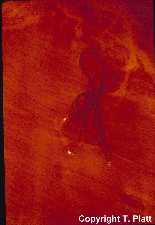|
|
| |
| Causative Agent |
-
Muscle worms are
nematodes that parasitize muscle and
lung tissue of some
cervids.
-
Two species are known to
cause disease in BC:
-
Parelaphostrongylus andersoni
-
muscle worm of caribou (Rangifer
tarandus) and occasionally white-tailed deer (Odocoileus virginianus).
-
Adult worms, which are delicate and thread-like, are found in association
with blood vessels and
connective tissue of the loin and thigh
muscles.
-
Adult worms are often found in the meat of backstraps, back muscles close
to the vertebrae.
-
Adult worms are 19 - 35 mm in length and approximately 0.1 mm in width.
-
The dark, threadlike intestine of adult worms is noticeable against
muscle tissue.
-
P. odocoilei
-
muscle worm of
primarily of mule and black-tailed deer (O.
hemionus); occasionally, mountain goat (Oreamnos
americanus), mountain sheep (Ovis
canadensis) and caribou are infected.
-
Adult worms are delicate, thread-like, and white, with a central thin,
black intestine. Like P. andersoni, they are found in
association with blood vessels and
connective tissue of the loin and other muscles.
-
Adult worms are about 55 mm in length and approximately 0.2 mm in width.
|
| Images |
|
Click on
image to
enlarge. |
 |
|
Adult muscle worm,
P. odocoilei,
in muscle of mule deer from Alberta. |
|
| Distribution |
|
Geographic: |
-
P. andersoni has been documented in
northern BC, as well as in the southeastern and south-central
areas of the province.
-
P. odocoilei has been
documented on Vancouver Island, in the Okanagan Valley, and
in coastal mountain goats and some populations of mountain
sheep.
|
|
Seasonality: |
-
New infections begin during periods when vegetation is greening up.
-
Larvae are passed in the feces at varying intensities throughout the
year.
|
|
| Hosts, Transmission and Life
Cycle |
| P. anderonsi: |
-
Adult male and female worms are often found paired.
-
Females deposit eggs into veins of hosts which are then carried to the
lungs where they hatch in small blood vessels.
-
Larvae move up the through the lungs and into the trachea where they are
coughed up, swallowed, and passed in the feces.
-
Larvae must then penetrate the body of a land snail to develop into the
infective stage.
-
The snail and infective larvae are then inadvertently ingested by caribou
and white-tailed deer while feeding.
|
|
P. odocoilei: |
-
Similar to that of P. andersoni.
|
|
| Signs and Symptoms |
| P. anderonsi: |
-
Natural infections in caribou and white-tailed deer are generally well
tolerated.
-
In general, the signs listed below are observed in heavily infected
animals; young are more susceptible than older animals.
-
Notable signs in caribou include:
-
reluctance to stand;
-
weakness;
-
panting;
-
short steps;
-
arched back.
-
Signs in white-tailed deer are more severe and include:
-
hemorrhage
on
the surface of back and thigh muscles;
-
green
abscesses may be observed near eggs
in lungs or worms in muscle;
-
small (up to 1 mm in
diameter)
nodules may be observed in the
lung.
|
| P. odocoilei: |
-
Outward signs of disease are rarely seen with P. odocoilei.
-
Laboured breathing may be observed in some infected animals.
-
Other signs are similar to those described above for white-tailed deer
infected with P. andersoni.
-
Recent research has identified this parasite in mountain sheep and
mountain goats. There is some evidence that heavy infections of
larvae can damage the lungs of Stone’s sheep, but further studies
are required to understand any role the parasite plays in the health
of these sheep.
|
| Meat Edible? |
-
Carcasses containing P. odocoilei and P. andersoni are safe
for human and animal consumption since they do not affect the
quality of meat.
|
| Samples for Diagnosis |
-
Submission of adult worms from loin or thigh muscles is necessary to
confirm infection.
-
Submitting fecal samples may also aid in diagnosis.
|
| Further Reading |
-
Lankester M.W. 2001. Extrapulmonary lungworms of Cervids. Pp. 228-278 in
W.M. Samuel, M.J. Pybus, A.A. Kocan (eds.),
Parasitic Diseases of Wild
Mammals. 3rd Ed. Iowa State University Press. Ames, IA.
|
|
|
